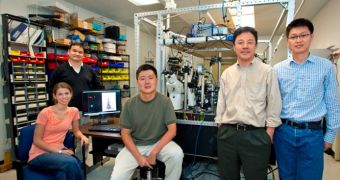For years, physicists have been observing a peculiar phenomenon in metal surfaces on which light was shone. Mysterious electromagnetic “hotspots” appeared to develop on them, but only at the nanoscale. A team of experts now believes it has discovered the missing piece to this puzzle.
The work was conducted by physicists at the US Department of Energy's (DOE) Lawrence Berkeley National Laboratory (Berkeley Lab), in California. They used an observations method called Brownian Emitter Adsorption Super-resolution Technique (BEAST) to image the hotspots.
According to the group that conducted the investigation, this single-molecule imaging technology was more than capable of measure various details of the electromagnetic fields inside the hotspots directly. This is the first time such a study is being conducted.
Scientists now say that the measurements obtained in the new study could be of use in refining and improving a number of other technologies, such as for example chemical sensing methods.
“With our BEAST method, we were able to map the electromagnetic field profile within a single hotspot as small as 15 nanometers with an accuracy down to 1.2 nanometers, in just a few minutes,” explains researcher Xiang Zhang.
“We discovered that the field is highly localized and, unlike a typical electromagnetic field, does not propagate through space,” adds the expert, who was the principal investigator of the study.
“The field also has an exponential shape that rises steeply to a peak and then decays very fast,” Zhang adds. He holds an appointment as a researcher at the Berkeley Lab Materials Sciences Division.
The expert is also the Ernest S. Kuh Endowed Chaired Professor at the University of California in Berkeley (UCB), and the director of the Center for Scalable and Integrated NanoManufacturing (SINAM) at the university.
Zhang was the corresponding author of a new paper describing the results, while experts Hu Cang, Anna Labno, Changgui Lu, Xiaobo Yin, Ming Liu and Christopher Gladden were coauthors.
The study appears in a paper entitled “Mapping the Distribution of Electromagnetic Field Inside a 15nm Sized Hotspot by Single Molecule Imaging,” which is published in the latest issue of the esteemed scientific journal Nature.
“Amazingly, despite thousands of papers on this problem and various theories, we are the first to experimentally determine the nature of the electromagnetic field inside of such a nanosized hotspots,” explains lead study author and research team member Hu Cang.
“The 15 nanometer hotspot we measured is about the size of a protein molecule. We believe there are hotspots that may even be smaller than a molecule,” he concludes.
Funds for the new study were provided by the Office of Science at the DOE.

 14 DAY TRIAL //
14 DAY TRIAL //